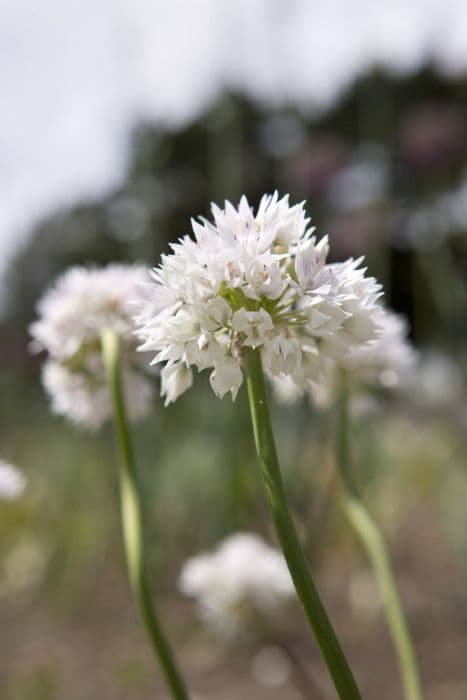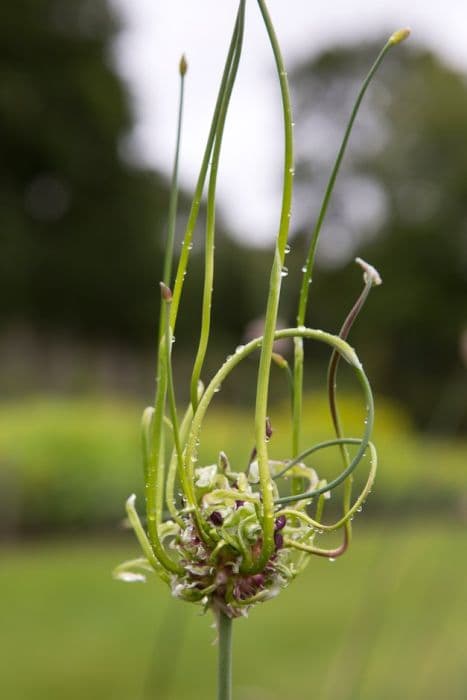Lombardy Garlic Allium insubricum

ABOUT
Allium insubricum, commonly known as the Lombardy garlic, is a perennial plant notable for its ornamental features. This plant typically bears a rosette of basal leaves that are long, slender, and grass-like. The foliage has a deep green color, giving it a vibrant appearance at the base. As the season progresses, the Lombardy garlic produces a flower stalk topped with a spherical inflorescence. The flower head is composed of numerous small, star-shaped blossoms, tightly packed together. These blooms display a striking shade of pink or purple, lending a pop of color to the landscape. The individual flowers are delicate and intricate, with six petals, and their arrangement in a dense cluster provides a showy display. The overall impression is a plant that exhibits both structural elegance with its slim, vertical growth habit and botanical beauty through its eye-catching flower heads.
About this plant
 Names
NamesSynonyms
Lombard Garlic, Insubric Onion
Common names
Allium insubricum
 Toxicity
ToxicityTo humans
The plant known as Allium insubricum, commonly referred to as the wild onion, is not generally considered toxic to humans. However, it is important to note that members of the Allium family can cause unpleasant reactions in some individuals when consumed in large quantities or if someone has a sensitivity to this group of plants. Symptoms of such a sensitivity may include gastrointestinal distress such as nausea, vomiting, and diarrhea. More severe reactions, while rare, could occur in individuals with a particular allergy to this type of plant.
To pets
Allium insubricum, or the wild onion, is toxic to pets, particularly cats and dogs. Members of the Allium genus, including onions, garlic, leeks, and chives, contain compounds known as thiosulfates which can be harmful to pets if ingested. Symptoms of Allium toxicity in pets include gastrointestinal upset like vomiting and diarrhea, as well as more serious conditions such as lethargy, abdominal pain, and an elevated heart rate. One of the most dangerous consequences is the potential for oxidative damage to red blood cells, leading to hemolytic anemia. If a pet ingests this plant, prompt veterinary attention is crucial.
 Characteristics
CharacteristicsLife cycle
Perennials
Foliage type
Deciduous
Color of leaves
Green
Flower color
Pink
Height
1-2 feet (30-60 cm)
Spread
1 foot (30 cm)
Plant type
Bulb
Hardiness zones
4
Native area
Europe
Benefits
 General Benefits
General Benefits- Environmental Enrichment: Allium insubricum, commonly known as Lombardy Garlic, can enhance the biodiversity of an area by introducing a new species to the ecosystem, potentially providing a new food source or habitat for local wildlife.
- Landscape Aesthetics: With its attractive flower heads, Lombardy Garlic can contribute to the visual appeal of gardens and natural landscapes.
- Erosion Control: The root system of Allium insubricum can help stabilize soil and reduce the risk of erosion, particularly in rocky or sloped areas.
- Pollinator Support: The flowers of Lombardy Garlic can provide nectar and pollen for a variety of pollinating insects, promoting pollinator health and diversity.
- Culinary Use: Parts of Lombardy Garlic may be edible, adding flavor and nutritional value to dishes, although care should be taken to confirm edibility and avoid confusion with similar-looking toxic plants.
- Educational Value: Studying and growing Lombardy Garlic can serve as an educational tool for learning about botany, ecology, and conservation.
- Cultural Significance: Certain plants, including Allium insubricum, may have cultural or historical importance in specific regions, contributing to the heritage and traditions of those areas.
 Medical Properties
Medical Properties- Antimicrobial: Allium insubricum may possess antimicrobial properties that could help in fighting bacterial infections. Allium species are known for their sulfur-containing compounds that have been shown to inhibit the growth of certain bacteria.
- Antioxidant: The plant could have antioxidant effects due to the presence of various phytochemicals such as flavonoids and sulfur compounds, which may help in neutralizing free radicals and preventing oxidative stress.
- Cardiovascular health: Similar to other Allium species, Allium insubricum might contribute to cardiovascular health by promoting healthy blood lipid profiles and aiding in the regulation of blood pressure.
 Air-purifying Qualities
Air-purifying QualitiesThis plant is not specifically known for air purifying qualities.
 Other Uses
Other Uses- Allium insubricum, commonly known as the Lombardy garlic, can be used in landscape gardening to add a splash of color with its characteristic pinkish-purple flowers.
- The plant's fibrous roots can help prevent soil erosion when planted on slopes or in areas prone to soil loss.
- Dried stems and flowers of the Lombardy garlic can be used in floral arrangements for their structural interest and long-lasting qualities.
- The strong scent of Lombardy garlic can potentially deter certain types of pests and rodents in gardens or storage areas.
- Lombardy garlic's nectar-rich flowers are attractive to pollinators like bees and butterflies, making it a good choice for an eco-friendly garden.
- The seeds of the Lombardy garlic can be collected and used for propagation to grow more plants or to share with fellow gardening enthusiasts.
- As an ornamental, Allium insubricum can be planted in a pot for a balcony or patio where garden space is limited.
- The plant can be used in a culinary herb garden as a decorative border that also provides a mild garlic flavoring, though it is not commonly cultivated for edible purposes.
- Allium insubricum can be planted in mass groupings for a bold visual impact due to its height and distinct flower shape.
- The plant can add seasonal interest to a perennial bed, with late spring to early summer blooms that stand out amongst other green foliage.
Interesting Facts
 Feng Shui
Feng ShuiThe plant Allium insubricum is not used in Feng Shui practice.
 Zodiac Sign Compitability
Zodiac Sign CompitabilityThe plant Allium insubricum is not used in astrology practice.
 Plant Symbolism
Plant Symbolism- Perseverance: Known commonly as the Lombardy garlic, Allium insubricum often grows in rocky, challenging environments, symbolizing the ability to overcome obstacles and endure tough conditions.
- Protection: Garlic plants in general are often thought to ward off evil spirits and bad luck, which may extend to the Lombardy garlic as a symbol of spiritual defense.
- Healing: Historically, alliums have been used for their medicinal properties, making the Lombardy garlic a symbol of health and healing.
- Unity: The tightly clustered flowers of the Allium insubricum can represent the unity and togetherness of individuals coming together as a whole.
- Humility: Not as widely cultivated or recognized as other alliums, the more understated presence of the Lombardy garlic can symbolize modesty and simplicity.
 Water
WaterThe Lombardy garlic needs to be watered regularly to maintain moist soil, particularly during the growth and blooming periods. Water the plant deeply once a week, providing about 1-2 gallons depending on the size of the plant and the weather conditions. During hot, dry spells, you may need to water the Lombardy garlic twice a week, ensuring that the water penetrates to the roots without causing waterlogging. Reduce watering after the blooming period as the plant enters dormancy.
 Light
LightLombardy garlic thrives in full sun, so it's best to position it in a spot where it can receive at least 6 hours of direct sunlight daily. Ensure that it's planted in an area with bright, unfiltered sunlight to promote healthy growth and vibrant blooms.
 Temperature
TemperatureLombardy garlic prefers temperate climates and can survive minimum temperatures down to about 20°F. The plant's ideal temperature range for vigorous growth is between 60°F and 70°F. It is important to protect it from temperatures below 20°F to prevent freezing damage.
 Pruning
PruningPruning Lombardy garlic is not often necessary but can be done to remove spent flower stalks and tidy up the plant. Prune back foliage to the base in late autumn after it has died down, to encourage new growth in the spring. Pruning immediately after flowering will help maintain the plant's appearance and prevent self-seeding if desired.
 Cleaning
CleaningAs needed
 Soil
SoilLake Como Garlic thrives in well-drained soil with a rich organic mix. A soil pH of 6.5 to 7.0 is optimal. Mix in compost and a little sand to improve drainage.
 Repotting
RepottingLake Como Garlic doesn't require frequent repotting. It should be repotted every 2-3 years or when it becomes pot-bound.
 Humidity & Misting
Humidity & MistingLake Como Garlic does best in moderate humidity conditions but is generally tolerant of variations in humidity levels.
 Suitable locations
Suitable locationsIndoor
Place Lake Como Garlic in a well-lit area inside, avoiding too much direct sun.
Outdoor
Plant Lake Como Garlic in partial shade to full sun in fertile soil.
Hardiness zone
5-8 USDA
 Life cycle
Life cycleAllium insubricum, commonly known as Insubric onion, begins its life cycle as a seed that germinates in well-drained soil, with a preference for sunny locations. Upon sprouting, it develops a root system and a shoot that grows into a slender stem. The leaves are typically narrow and grass-like, emerging early in the growth cycle. The Insubric onion produces a characteristic globular inflorescence composed of small, star-shaped flowers, usually blooming in late spring to early summer. After pollination, often by bees and other insects, the flowers develop into seed capsules containing black seeds that are eventually dispersed, continuing the propagation of the species. The plant is perennial, with bulbs lying dormant underground during the winter, to re-sprout the following spring.
 Propogation
PropogationPropogation time
Spring-Early Summer
Propogation: Allium insubricum, commonly known as the Lombardy garlic, is typically propagated through division of its bulbs. The ideal time to propagate is during its dormancy period after the foliage has died back, usually late summer to early fall. To propagate by division, the clumps of bulbs are carefully dug up and individual bulbs are gently separated, ensuring that each bulb retains a portion of the root system. These bulbs can then be replanted immediately at a depth of about two to three inches (5-7.5 cm) and spaced approximately six to eight inches (15-20 cm) apart to allow for sufficient growing space. Water the newly planted bulbs moderately to help establish them. This method utilizes the plant's natural reproductive strategies and typically results in a high success rate for new plant growth.








